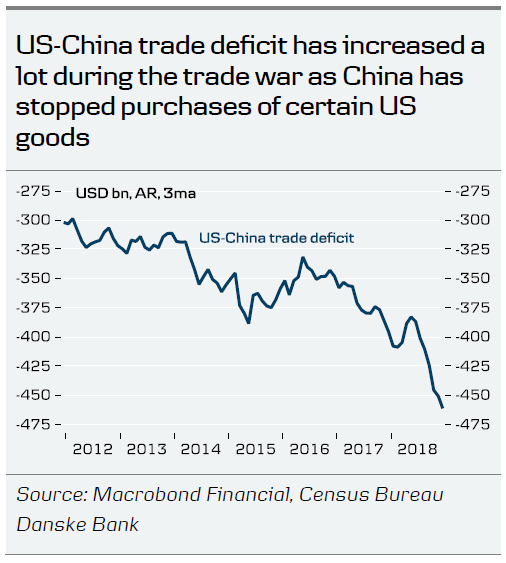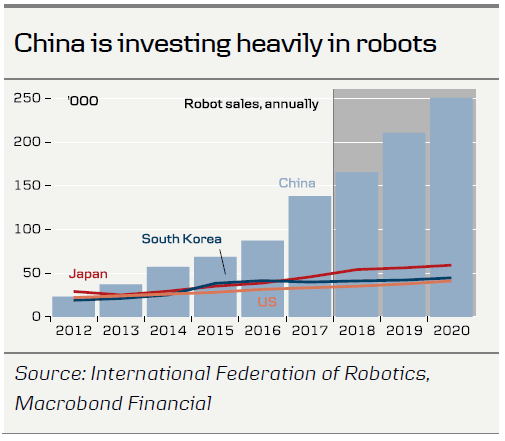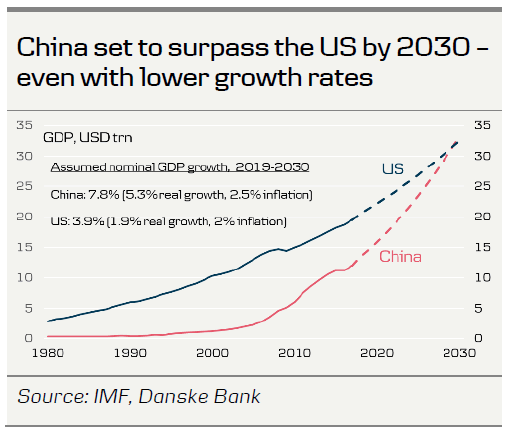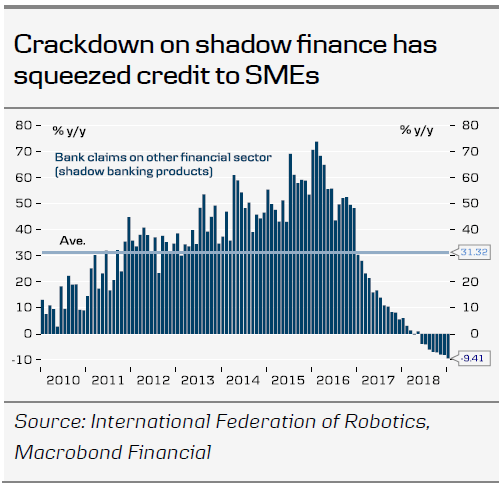Key points
- The trade war is set to end soon but the tech war is here to stay.
- China’s rise and the relative decline of the US are set to create friction in years to come.
- China’s tech rise is moving fast but the country still depends on US tech in key areas.
- We witnessed China’s rapid development within artificial intelligence close up in a ‘Dream Town’ in Hangzhou.
- We do not expect China to hit a debt crisis but credit availability for the private sector is a big challenge
A week ago, we came back from a trip in China, which took us to Shanghai, Hangzhou and Hong Kong. We talked to a wide range of people at companies, research houses, academics, institutions and visited an ‘Artificial Intelligence Dream Town’. Below are the main takeaways from our trip.
From trade war to tech war
Not surprisingly, the trade war is currently at the forefront of all discussions in China. There is now broad consensus that a trade deal is coming but views differ on what kind of deal it will be. A sceptical camp dominates, which sees a ‘weak deal’ that the US hawks are not going to like and that could lead the trade issue to flare up again later. However, Donald Trump now wants a deal, as he will be setting out on the campaign trail soon and wants a deal with China in the package that carries gifts to key voters, as well as a strong economy and rallying equity markets.
However, the consensus view is that trade deal or not, the ongoing tech war between the US and China is set to continue. This implies (a) very strict investment restrictions on Chinese companies in the US, (b) more export controls on technology, (c) targeting specific Chinese tech companies (such as Huawei) and (d) aiming to build an alliance with other western countries to limit Chinese access to western technology.
It is clear that sentiment among US observers of China has taken a sharp turn to a more critical stance. There are few ‘panda huggers’ left in Washington as well as among Americans in China. The negative view is bipartisan and widespread and includes the media and academics as well. Trust between the US, the sole super power since the end of the cold war in 1991, and the rising power of China, is at a low point. Almost everyone expects the friction to continue as China grows bigger and more confident and the US defends its position as the world’s super power and aims to contain the rise of Chinese influence in the world.
The change in US sentiment has happened rapidly in recent years and is a consequence of many things. Over the past five years, under Xi Jinping, it became clear that China is not moving towards a system of western democracy. Instead, it plans to stick to a one-party system based on old Chinese traditions, with a very strong state. The removal of the two-term limit on the presidency in 2018 underlines this. In addition, China has increased its presence on the global stage with the Belt and Road Initiative, initiating the AIIB and the BRICS bank, and increasing its military role in the South China Sea. The time when China kept a low profile (Deng Xiaoping’s ‘hide your strength, bide your time’) on the global stage is over. Finally, an increase in control and surveillance, combined with human rights issues, has hardened the stance towards China in the US.
Most people doubt that we are entering a new ‘cold war’ in the old sense that we will get two separate blocks. The world is much too integrated for this today and the economic cost for the west would be substantially higher (missing out on Chinese growth) compared with what was the case in the Cold War with the Soviet Union. For most countries, it is set to be a balancing act, with one foot in each camp but further in one than in the other.
Geopolitical tensions are likely to continue with further conflicts in the South China Sea, friction regarding Taiwan and the US looking to offer an alternative to the Belt and Road Initiative and warning other countries not to join it. We are already seeing the US and China using both carrot and stick approaches with other countries to get them on ‘their side’ or at least not to oppose them. However, the US is gradually losing relative power and we may see more countries catering to China in order to reap the economic benefits of a good relationship with China, not least the other emerging markets and developing countries.
China’s tech rise is rapid but it is still behind in some key areas
Another issue that is high on the agenda in China is the very rapid rise within tech. China has already moved to the frontier in areas such as mobile phones, 5G networks, super computers, e-commerce, mobile pay, high-speed trains and drone technology and is moving very fast within artificial intelligence. China is still lacking behind within semiconductors, robots, manufacturing technology and aviation. It is still highly dependent on the US within semiconductors and the whole ecosystem needed to catch up in this area implies that it will take at least five to 10 years. However, China is set to double its investments to speed this up, as the trade war has made it clear that China is very dependent on the US in this field and thus vulnerable.
Within artificial intelligence, China has some clear advantages in a very large population providing significant amounts of data. China’s tech development also benefits from millions of engineers being educated every year and a very strong work ethic among start-ups, which involves working ‘996’ (09:00 to 21:00 six days a week) and in some cases ‘997’.
On our visit to Hangzhou (a city one hour from Shanghai, with 9 million people), we had a tour of an Artificial Intelligence Dream Town, which was a spectacle of China’s speed within the tech area. The Dream Town hosts 2,000 people working in start-ups, who focus on artificial intelligence. Each month 30 start-ups compete for four places in the Dream Town. Here they are affiliated with incubator funds and have free accommodation for three years, sponsored by the government. There is a close co-operation with universities nearby and the tech giant Alibaba, which has its headquarters in Hangzhou (CEO Jack Ma’s hometown).
The exhibition centre was a glimpse into the future of how artificial intelligence will become part of our lives in a completely new way and how China is likely to be at the forefront of this development, competing head to head with the US. We witnessed how China is also ahead in using drone technology. A drone delivery installation close to a KFC and Starbucks in the middle of the Dream Town can deliver food and coffee within a radius of 3km. The customer enters the order into a KFC or Starbucks app and one of the outlets personnel puts the delivery in a box attached to the drone, which then delivers it. Unfortunately, we did not have time to try it but our hosts told us it was running and working well.
Hong Kong and Greater Bay Area
The last stop on our trip was Hong Kong. The city continues to thrive on Chinese growth and is home to a vibrant financial community and a host of foreign and Chinese companies. Hong Kong is set to become increasingly integrated with the mainland as part of the Greater Bay Area project, which aims to create a high-tech economic and financial powerhouse. The Greater Bay Area will link nine cities in Guangdong province with Hong Kong and Macau (see more here The plan is to leverage the strong financial centre and trade hub of Hong Kong with the high-tech capabilities of cities such as Shenzhen (called the Silicon Valley for hardware) and Guangzhou. The Hong Kong-Zhuhai-Macau Bridge, which opened earlier this year, is part of a vision to increase integration and foster a world-leading economic zone. The Greater Bay Area zone is home to 67 million people and has a GDP of USD1.39trn, almost double the size of the San Francisco Bay Area GDP of USD0.78trn. By 2030, China expects the area’s GDP to triple to the size of the German economy today.
No debt crisis but struggle to get credit to the private sector
While in Hong Kong, we also had the chance to discuss the Chinese challenges relating to debt and inadequate credit availability for the private sector. A meeting with the IMF and an asset manager threw more light on the battle to deleverage state-owned enterprises (SOEs) and reduce risks from shadow banking while at the same time securing credit availability for the SME companies in the private sector.
Over the past two years, China has elevated financial risks to the top of the political agenda. Deleveraging of highly indebted SOEs and controlling the risks from rapid growth in shadow finance have been at the forefront of the government battle against risks to the economy. However, the crack down on shadow finance in particular has had a significant negative effect on the private sector, especially SMEs. Shadow finance products (such as wealth management products) have been key in allocating capital from Chinese households to private sector companies. While the large banks prefer to lend to SOEs, the smaller and medium-sized banks have generally been the place for SME companies to get funding. The loans were increasingly off balance via wealth management products and other savings products, which made the financial system more vulnerable. As a consequence, the government has tightened significantly rules on wealth management products, trust loans, etc., which has added more loans back to the balance sheets of small and medium-sized banks. Consequently, they have had to set aside more capital and it has hampered their lending capacity and thus restricted credit availability for companies. Adding the trade war on top of this has created a perfect storm that has thrown a lot of sand in the lending machine to private companies.
The government and central bank are keenly aware of this and have taken many steps over the past year to incentivise banks to lend more money to the private sector. However, it has widely been like pushing on a string and it is still a key challenge to unlock this credit squeeze. We believe we are likely see more measures this year to do this. The government is also said to be relaxing the rules a bit on shadow finance again to open up again this credit channel a bit more for the private sector (see SCMP, 10 March for more on this). However, the government keeps facing the balancing act of underpinning growth in the short term while not creating new risks for the longer term. This is also something premier Li Keqiang mentioned specifically in his Work Report at the National People’s Congress last week.
Conclusion: trade war set to end, tech war to continue and China to stay on track for surpassing the US
To sum up, this was another very giving trip that opened up yet new sides to the Chinese box of complexity, opaqueness and at the same time economic vibrancy. We came away with the impression that the trade war is set to end soon but that the US-China rivalry is far from over. In addition, we believe we will have to get used to living with the possibility that new areas of friction could flare up from time to time. In our view, there is no doubt that the tech war is here to stay. We also witnessed again close up the Chinese speed in development and investments when it comes to innovation and tech and we were reminded of the challenges that China also faces, not least in recalibrating its financial system to make it more stable, while at the same time securing credit for the most productive parts of the economy. However, we see adaptability and focus on solving problems as one of the key strengths of the Chinese economy. Hence, we expect it to continue to be the bumblebee that should not be able to fly and yet does. We are still optimistic that China can overcome the numerous challenges it faces (only a few of which we mention here) and continue its rise to become the biggest economy in the world over the next 10-15 years as it surpasses the US around 2030. We expect continued high growth and plenty of opportunities but also more competition as Chinese companies become more efficient and increasingly go global.















